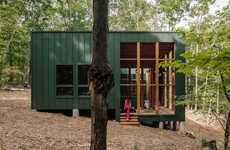The hyperbolic paraboloid dubbed the 'Hypargate' was created by a research group from the Polytechnic University of Bari and engineers from the Roma Tre University.
Though minimalist in its final form, the installation called for the revival of an ancient art known as 'stereotomy,' which is described as "a process that draws upon geometrical knowledge and techniques of cutting blocks of stone into complex frameworks." In order to create Hypargate, researchers and engineers had to take incredibly precise mathematical equations into account, which ensured its structural success.
Located in France, the installation was made as a means to frame the entrance of the SNBR headquarters. The hyperbolic paraboloid swoops down elegantly overhead and is supported on either side with thick supports that complement the flow of the rest of the design. Meanwhile, holes perforate the top of it, allowing light to seep through. Photo Credits: designboom, en.poliba.it
Bending Geometric Installations
The Hypargate is a Hyperbolic Paraboloid Made Entirely of Stone
Trend Themes
1. Geometric Installations - The use of complex geometrical forms in installations presents opportunities for architects and engineers to explore their creativity and challenge traditional design principles.
2. Stereotomy Renaissance - The revival of ancient techniques, such as stereotomy, highlights an opportunity to apply historical knowledge to modern-day engineering challenges and create innovative designs.
3. Mathematical Precision - The use of mathematical equations to ensure the structural success of installations presents opportunities to push the boundaries of technology and design.
Industry Implications
1. Architecture - The use of complex geometrical forms in architectural design presents opportunities for architects and designers to create aesthetically pleasing structures that also serve functional purposes.
2. Construction - The revival of ancient techniques, such as stereotomy, presents new opportunities for construction companies to incorporate traditional methods with modern technology to create innovative designs.
3. Engineering - The use of mathematical equations to ensure the success of installations presents opportunities to engineers to push the boundaries of technology and design and create innovative structures.




